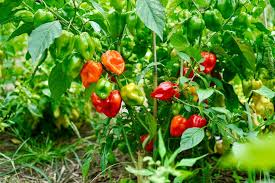Planning to grow peppers this season? Great! Pepper
s are chock-full of good flavor and nutrition. Here’s a step-by-step guide to help you reap your best pepper crop ever, whether you’re starting with your own transplants or planting ones you bought at your local garden center.
1. Prep the site.
The right site can make all the difference in how well peppers perform. Choose a sunny, well-drained spot where peppers haven’t grown recently. The soil should be deep, rich, and loamy. If yours isn’t, amend it with about 1 inch of compost.
Avoid adding too much nitrogen to th
e soil, however. Excessive nitrogen can cause the pepper plants to grow too fast, making them more susceptible to disease and less productive.
2. Harden off seedlings.
Before you plant your pepper seedlings, you’ll need to harden them off by gradually exposing them to outdoor conditions. This process helps seedlings adjust, so they’ll be less stressed when you plant them. And less stress means bigger, more productive peppers.
When daytime temps reach the mid-60s, set the seedlings in a sheltered location outdoors, such as next to the house or garage, for a few hours each day for three or four days. Over the next week, slowly extend that outdoor time. Meanwhile, as the pepper seedlings become accustomed to the outdoors, you can warm the pepper bed by covering it with dark landscape fabric.
3. Plant.
Peppers like warmth, so wait to plant until nighttime temperatures have consistently reached 60 degrees and all danger of frost has passed. If possible, set out your peppers on a cloudy day to help reduce stress on the plants. Space the plants 12 to 20 inches apart, depending on the mature size of the variety, and set them a bit deeper than they were in their containers. (Like tomatoes, peppers grow extra roots from the buried portion of the stem.)
Stake or cage taller varieties so that the stems do not break in strong winds or due to a heavy fruit load. After you plant the pepper seedlings, water them well.
4. Water and mulch.
Throughout the growing season, make sure your pepper plants receive at least an inch of water a week. Check the peppers often during periods of extreme heat and drought, when each plant can easily take a gallon of water a day. If you live in a very hot, arid region, add a thick layer of mulch to help retain soil moisture and moderate the soil temperature. But do this only after your soil has warmed — mulching cool soil will keep it too cool and stunt the pepper plants’ growth.
5. Pinch off the first flowers.
As weird as it may seem, pinch off any early blossoms that appear on your pepper plants. This won’t harm the plants. In fact, it helps them direct their energy into growing, so you get lots of large fruits later in the season (and a higher overall yield) instead of just a few small fruits early on.
6. Harvest your peppers!
You can harvest the peppers at their immature green or purple stage, but the flavor will be sweeter if you wait for them to reach their mature color — usually red, but sometimes golden yellow or orange.
Italian fryers, jalapenos, and Cubanelles are possible exceptions: Many people prefer the flavor of these peppers when they are full size but still green. To harvest the peppers, cut them off with hand pruners. Pulling them off by hand can damage the plant.

